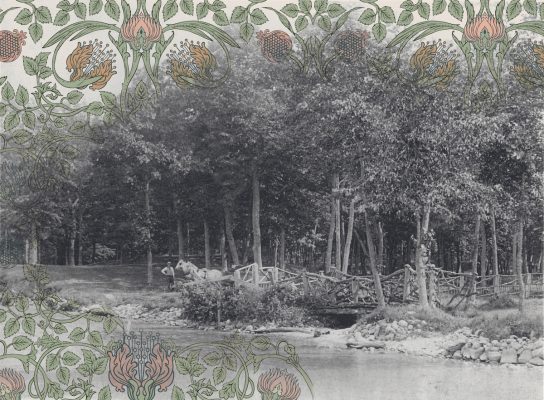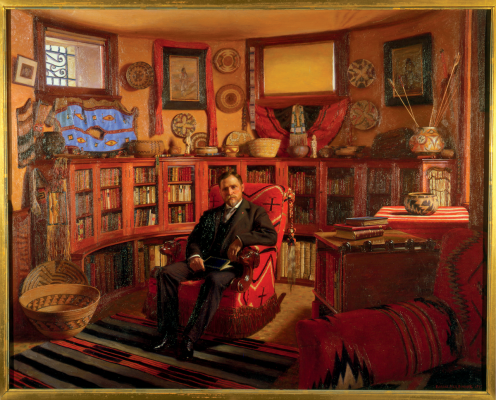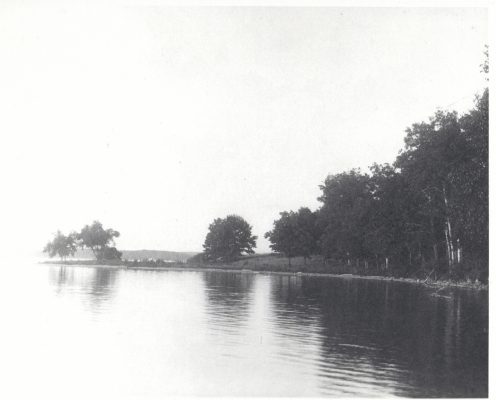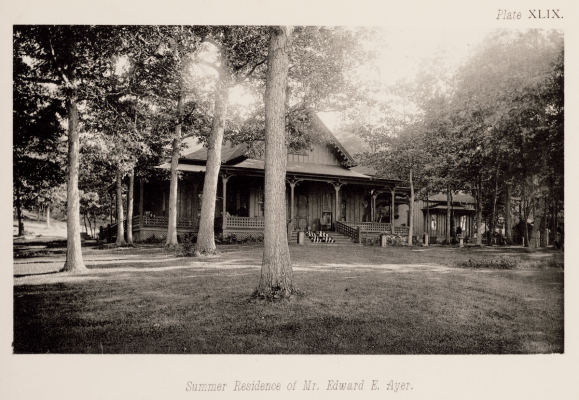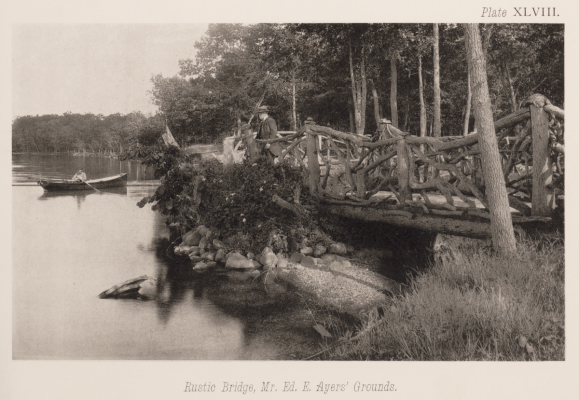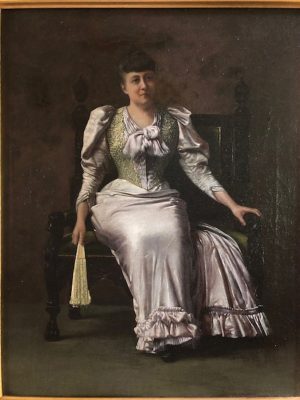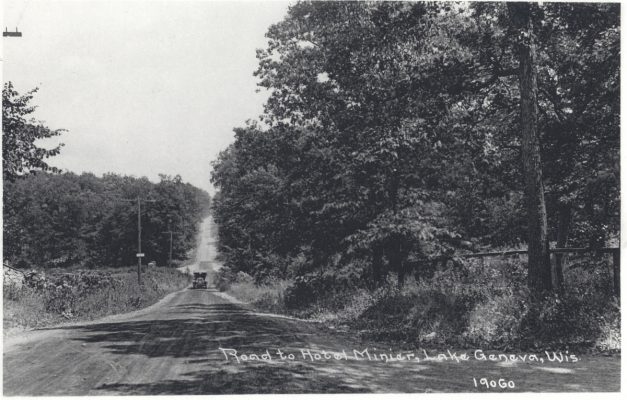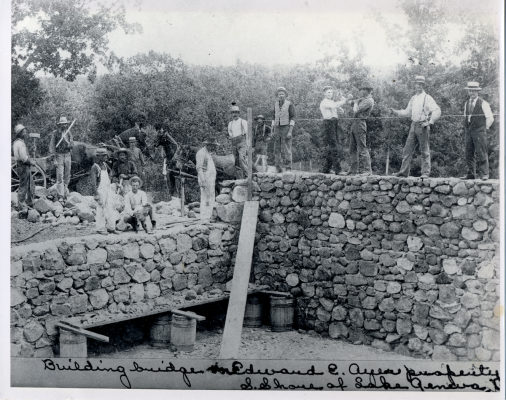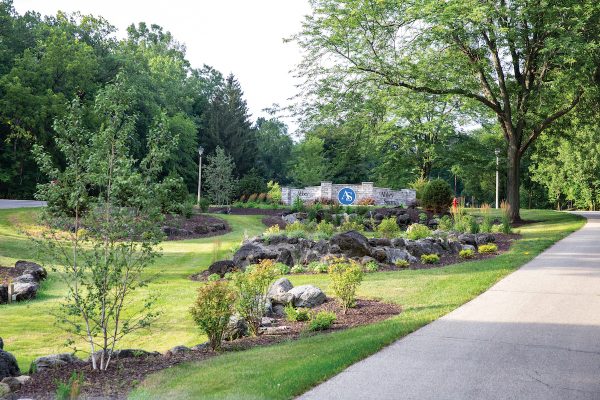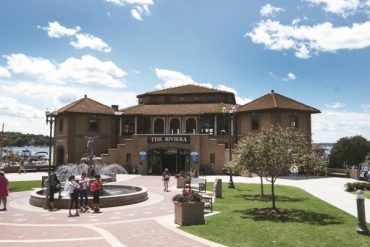By Sarah T. Lahey | First/Top Photo courtesy of Laurie Buss
Imagine for a moment that you are departing for a boat ride around the lake on a crisp fall afternoon, leaving from the Fontana Municipal pier and heading along the lake’s south shore. Just a mile or so east of the Fontana Beach, you will pass the historic lakefront cottages of the Harvard Club subdivision, and then drift past the shared beach, yacht club and marina of the Abbey Springs subdivision. Incredibly, all of this lakefront property, plus an additional 1,200 acres of land stretching back from the lake, used to belong to one intrepid and fascinating couple: Edward and Emma Ayer.
To give you an idea of the sheer vastness of 1,200 acres, the land that the Ayers owned at the end of the 19th century and beginning of the 20th century could have accommodated more than 900 modern NFL football fields. The Ayers used that land to establish two separate farms and more than five miles of walking paths. They also built a modest lakefront home called The Oaks, where they spent time in the summer when they weren’t engaged in extensive, round-the-world travel. Despite their significant wealth, Edward and Emma Ayer did not want a grand mansion, so they built The Oaks as a relatively humble cottage near the water, and it remained standing on the site for nearly 100 years.
HARVARD ROOTS
Edward Ayer was the son of Elbridge Ayer, an early settler who arrived in the Midwest before Wisconsin even became the 30th state. An entrepreneur and risk-taker at heart, Elbridge opened a general store in Kenosha, and then sold it to purchase some overlooked land on the Wisconsin-Illinois border. In fact, Ayer had an active business interest in the Chicago & Northwestern Railroad, which he knew was expanding service from Chicago to Janesville, Wisconsin. The property he purchased sat conveniently along the new train line. Elbridge acquired as many acres as possible and founded the town of Harvard, Illinois, in 1856, moving his family there. This ambitious entrepreneur-ism would influence young Edward, who had a similar taste for adventure all his life.
THE WILD WEST
At age 19, Edward Ayer left Harvard to travel west, stopping briefly in Silver City, Nevada, where he worked in a quartz mill for 12 hours a day. In his memoir, Ayer described Nevada as “the roughest place on earth,” and he stayed only long enough to earn train fare to San Francisco. He arrived with 25 cents to his name and found work in a saw mill. At the start of the Civil War, he enlisted in the First California Cavalry Volunteers, remaining in military service until 1864.
As the story goes, during Ayer’s time in the military, he was invited into the private library of Colonel Samuel Colt of gun-making fame, where he stumbled upon a copy of Prescott’s “Conquest of Mexico” and became transfixed. The experience ignited in Edward Ayer a lifelong passion for history, and he went on to become an avid book collector, eventually acquiring his own copy of “Conquest of Mexico,” which was priceless to him and now resides in Chicago’s Newberry Library.
Returning to Harvard after the war, Ayer’s father gifted him one-third of his general store. This was a generous offer, but Ayer had other ambitions. Working in the California saw mill had inspired him to pursue the manufacture of railroad ties. The historical records do not indicate exactly how Ayer met early Lake Geneva resident George Sturges, but it was not long before Sturges financed the formation of Ayer & Lord Tie Company when Ayer was just 24 years old. By the time he was 30, the company was selling nearly a million railroad ties a year, and Ayer became a very wealthy man.
MEETING EMMA BURBANK
Only a rare woman could have captured the heart of Edward Ayer, and Emma Burbank was a rare woman indeed. Edward and Emma married in 1865, and from that moment forward, their lives were never dull. When she wasn’t setting records with long- distance swims, Emma was planning trips to Asia, the Middle East and Africa. An avid scholar, she always packed extra books instead of clothes for these epic journeys.
In fact, she was so frustrated that there were only two books available at the time about northern Africa that she published her own in 1911: “A Motor Trip Flight Through Algeria and Tunisia.” The book includes significant ethnological information, as well as hundreds of photographs taken by Emma Ayer herself. Very few American women traveled through Africa in the early 1900s, and even fewer wrote books about it. Stateside, Emma became one of the first non- native woman to descend into the Grand Canyon. A large butte, called Ayer Point, was named in her honor.
At Geneva Lake, Emma had always impressed people with her long- distance swims. As early as September of 1879, the “Lake Geneva Herald” observed that she — along with several other women — swam from Harvard Club across the lake to Camp Collie in Williams Bay in 2 hours and 10 minutes. Ever an athlete, Emma continued to swim from Harvard Club to Camp Collie well into her 70s.
BUILDING THE OAKS
With Emma by his side, Edward Ayer had found a partner for life — and after 10 years of marriage, the two decided that Geneva Lake provided the perfect respite from the business of railroad ties. In 1875, they purchased a jaw-dropping 1,200 acres of property on the lake’s south shore: 700 acres of farmland and 500 acres of dense oak forest. They sold 14 acres of their lakefront property to a group of friends from Harvard, Illinois, who used a portion of the land as a campground. Early Lake Geneva historian Paul Jenkins noted in the 1920s that the original estate included eight miles of driveways and an estimated five mile of walking paths, which the Ayers generously opened to the public.
The Oaks, the home they built for themselves on the lakefront, was much smaller than other lakeside “cottages” of the era built by families like the Sturgeses, Fairbanks and Leiters. Still, the grounds included a rose garden, a pergola, an aquatic garden, a fountain imported from Italy and several greenhouses. Their steam yacht, the Tula, could carry as many as 60 passengers. The Ayers did not require a fancy home, but they enjoyed their property to the fullest.
TRAVELERS AND COLLECTORS
While indulging in life on Geneva Lake, the Ayers also spent a significant portion of their later years traveling. They became some of the first Americans to travel through Europe by car — and according to Ayer’s biographer, Frank C. Lockwood, even traveled through the Sahara Desert that way as well. Their travel during this era was impressive. By 1903, Edward had crossed the ocean a total of 24 times and Emma 28 times.
Throughout their lives together, the Ayers had become passionate researchers of native cultures and they invested heavily in acquiring native artifacts. Over the years, they amassed a considerable collection of Native American artifacts (including several items they had discovered on their property on Geneva Lake), as well as antiquities from Egypt and Asia. In his 1912 “History of Walworth County,” historian Albert C. Beckwith indicated that the Ayers’ collection included “ancient chests, Oriental furniture … strange musical instruments and unique relics of various kinds.” In fact, historian Jenkins later claimed the Ayers owned the most spectacular collection of art and artifacts “in all America.”
GIVING BACK AND LEAVING A LEGACY
The Ayers were able to put this collection to good use through significant donations to historical and cultural institutions. In 1892, Edward Ayer became a charter member of the Newberry Library, and he donated over 17,000 items to its collection, including two letters from Christopher Columbus. The bulk of the items Ayer donated were related to American Indigenous Studies, and the library still maintains a collection in his name.
Ayer played a similarly integral role in the founding of Chicago’s famed Field Museum of Natural History. Aside from serving on the board, he convinced Marshall Field to contribute the $1 million necessary to establish the museum. The Chicago Tribune claimed that Field relented only after the following comment from Ayers: “You can sell dry goods until hell freezes over, but in 25 years, you will be absolutely forgotten.”
Ayer went on to serve as the Field Museum’s first president from 1893 to 1898, and was also an active member of the Wisconsin Historical Society and the Chicago Historical Society, as well as a member of the U.S. Board of Indian Commissioners. He financed the travel of his nephew, Elbridge Burbank, for the purpose of sketching and painting Native American people, a trip that produced portraits of nearly 1,200 individuals from 125 tribes. Elbridge Burbank’s work now graces the halls of the Smithsonian American Art Museum in Washington, D.C.
Emma Ayer was an avid philanthropist as well. She was an early founder of the Lake Geneva Fresh Air Association and Holiday Home Camp, both of which provided lake access to disadvantaged urban children and families in need.
SOLD TO THE HIGHEST BIDDER
The story of the vast collections amassed by Edward and Emma Ayer ends with an auction in 1934. After the death of Edward in 1927 and Emma in 1932, the estate became insolvent and their daughter, Elizabeth, was left to face the auctioneer. Items sold at the auction included Chippendale furniture, rare Oriental rugs, a 13th- century crossbow inlaid with ivory, Egyptian statues, an extremely valuable collection of ruby glass and Italian Renaissance artist Luca della Robbia’s painting, “Madonna and Child.”
In 1941, Elizabeth was forced to sell her family’s Lake Geneva estate. This must have been a painful loss for her, as her wedding at The Oaks several decades earlier had been a veritable “who’s who” of Lake Geneva society. At that time, the vast acreage surrounding The Oaks became a subdivision known as the Ayer Park Association, containing a handful of modest cottages, a chapel, tennis courts, croquet grounds and a lakeshore campfire site.
‘YOU CAN LIVE HERE’
Today, the Ayer family legacy lives on through the Harvard Club and Abbey Springs subdivisions. Abbey Springs, in particular, demonstrates the incredible size of 1,200 acres. Driving through Abbey Springs today, the winding roads are reminiscent of the miles of walking paths that the Ayers once opened to the public. At the waterfront, the Abbey Springs Yacht Club is rumored to rest on the original foundation of The Oaks.
With a grand opening in 1971, Abbey Springs advertised its lots with the slogan, “You can live here,” a fitting motto for the Ayer property. Today, Abbey Springs offers the opportunity of lake living to many families,and contains over 100 houses and condominiums, all of which share amenities and lake access. One hopes the Ayers would smile to know that so many families have lived on their property,experiencing lake life at its best.
TIES TO THE HARVARD CLUB
In 1875, Edward and Emma Ayer sold 14 acres of their vast property to a group of friends from Harvard, Illinois, who used four of those acres to found Harvard Camp. The land was divided into 50 square lots (just the right size for each family to maintain a large tent). Later, as the camp transitioned to a “club,” the members merged the camping lots to accommodate slightly larger cottages. However, the original homes at Harvard Club did not have kitchens; most residents ate their meals at the Hotel Minier, adjacent to the property, which was owned and operated by Edward Ayer’s sister, Julia Ayer Minier.
Today, the Harvard Club is known for its iconic rows of parallel homes, all of which have been updated to include modern amenities. But back in 1920, the community was known for keeping a strict code of conduct: no parakeets, no radios to be played on porches and no noise during nap hour.

